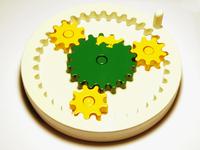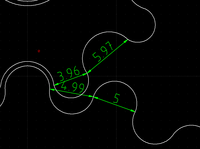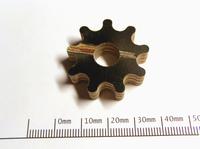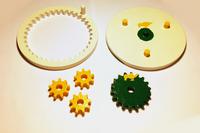Plywood gears

This is a technical gift to my nephew: plywood planetary gears. I had the opportunity to order some water jet cut parts for a work project, and after seeing the results I tried it in a hobby project also.
CAD model

I drew the gears in QCad (design file), which is a great open-source program for simple 2-dimensional CAD-drawing.
The biggest challenge was fitting the round teeth around the gear perimeter:
- Choose teeth width w and tolerance x to use between meshing teeth.
- Choose number of teeth n.
- Calculate gear diameter d = w * n / π and teeth angle α = 360° / n.
- Draw a circle with diameter d and then on it's circumfence, smaller circle with diameter w + x.
- Starting from the intersection of the two circles, draw a third circle with diameter w - x.
- Cut the small circles in half and remove unnecessary halves.
- You should now have a basic form for the teeth, one concave and one protruding curve.
- Use the rotate tool to make one rotated copy of the basic form, rotating around the middle point of the big circle.
- Adjust the endpoint of the form with snapping so that it aligns perfectly with the copy.
- Remove the copy (because it has not been adjusted for alignment) and make n new copies.
- Remove the big circle. Your gear is ready.
I used x = 0.5 mm for the gap between the gears. In retrospect this was a bit too large, leaving too much play in the gears.
Plywood


I ordered my parts locally from Tampereen Vesileikkaus Oy, for a total of 60 €. I guess the starting costs raised the price somewhat, I might have got it cheaper from some laser cutting place on the web.
The material is 6.5 mm film faced plywood. The film caused a bit of a problem with the water cutting because small details chipped away. However, I got replacement parts for free and they somehow managed to avoid the chipping.
Painting


I painted some ducks with templates made by my wife, to decorate the gears. Paints are water-based acrylic and there is a bonding primer underneath, both applied with a brush.
I quite much liked the end result. I've heard that the yellow ones are used more as toy pancakes than gears, though :)
Next time I might try something a bit more creative.
– Petteri Aimonen on 22.4.2011
